Last updated on July 27th, 2024 at 03:06 pm
Podcast: Play in new window | Download | Embed
Nacho Gomez a Sr Technical Program Manager from Amazon, contacted me to do a ‘Fireside Chat with TPMs from Amazon’. The goal was to debate and share ideas on different topics about the TPM role and career. Nacho joined Amazon as a TPM in 2017. He has around 20 years of experience with different technical management roles over the last 15 years in various industries. He is working now on Kindle in Amazon’s Madrid TechHub where he is an active member of the TPM community.
Nacho found this blog nearly 4 years ago when he looked for information about the TPM role and we were in conversations since last year to have this call with an audience of both, new hired and long-tenured TPMs.
Hope you enjoy this episode of the ‘TPM Podcast’.
Thank you,
Podcast Transcript
Nacho: Please everyone, help me welcoming Mario. Mario is a well-known member of the TPM community with 15 years plus experience working, currently as principal TPM at Oracle and owner and host of the TPM blog and the TPM podcast, helping people to either start or grow on their TPM career. Mario agreed to have this QA session with us. So over the next, let’s say 40 minutes I will be asking him about those interesting questions that we have been gathering from our local community of TPMs at Amazon in Madrid. And if you have any follow-up questions, please use the chat. I will try to accommodate times, or we can speak about them together either during the interview or at the very end. And as I mentioned, I am recording the session in order to capture the transcript later [00:58 inaudible] and check internally with Mario that we can distribute the video itself. Mario, Thank you again. It’s a pleasure having you here. Why don’t you briefly introduce yourself before we start with the questions?
Mario’s Introduction
Mario: Sure, sure. Thank you so much for having me. It’s really nice to meet TPMs, not only in another organization, but it’s also another country. So I think this is the first time I’m actually talking to a group of TPMs outside the United States. So that’s really cool. So a little bit background of how my career has transpired and how this all started. It starting off. It was a, I did my engineering in India and then I went on to do my MBA in UK, United Kingdom. Worked there for some time. Then I came back to India.
I worked at Oracle sales for nearly three years selling Oracle products in the United States. Then I got married, came to the United States and then, this was in 2009 and I could not find a job because of the economic troubles. And, you know, I was trying to move from India to United States. So I had to find myself a new job. And that’s when I started, I probably was jobless for nearly a year trying to figure out what I was supposed to be doing and all that. And then I started in quality assurance and testing. I started doing automated tests, became a test manager, a program manager, a TPM, and then the rest is like senior TPM in principle. So it’s been kind of an interesting journey to have been in different roles for the last 15, 20 years or so. So that’s been very interesting. So like seven, eight years ago, what happened was I started hearing a lot about the cloud in Seattle, probably more than eight years ago.
It was seven, eight years ago. Approximately seven, eight years ago. And then I was like, okay, how do I learn more about the cloud and all of these things? So I like, okay, let me just, you know, host WordPress site on AWS. That’s going to be my goal. And so I bought a domain and I stood up a WordPress site and I started slowly writing on the WordPress site, which was hosted on AWS. And that’s how my blog basically was born. And in this time when I’m writing, when I’m just starting the blog, I realized in Seattle, especially there was this new role, I was a project manager at that point of time, I was implementing ERP projects, which are kind of, you know, your finance systems, your HR systems, and those kinds of things. And then what happened was, as I said, so the TPM role is starting to gain prominence. And Amazon’s, one of those companies which kind of, they are hiring for the TPM role. But then the TPM role itself was so ambiguous. There’s even today it’s ambiguous.
Seven to 10 years ago, it was even more ambiguous. So my journey started talking and meeting with people from Amazon TPM, from Amazon. I live very close to the Amazon downtown office. So I used to go hit people up on LinkedIn and then go meet them for breakfast and coffee and beer and whatnot. And while I’m doing this and talking to people, I’m taking notes and I’m like understanding the role better. And even today, if you ask 20 TPMs, what TPMs do, you’re going to get a whole variety of answers. So I start taking notes and then I get a better sense of the role. And then I’m like, why don’t I share this with more people? Because this information is so rare and job descriptions are never well-written across all organizations. So it’s like, so that’s how this whole journey started. And now, you know it’s become a very popular website. I have a podcast which is very popular as well. I have a Udemy course, which has like around 3,500 students. So it’s like, it’s taken off really well. And I’m always happy to share that knowledge and help more people learn about the role. So that’s been a real good passion of mine and it’s been fun so far.
Why The TPM Role?
Nacho: This Is this a really exciting, interesting story, you know, and also you have answered I think the first question that we’ve had, which is why did you decided [05:20 inaudible] TPMs? I think that you covered already that.
Mario: Yeah, little more about that, I think is that I feel that the role, as I said, right, the role is really ambiguous. So it’s important to talk more about it and help people understand the role. Also, I feel if as I help people, I feel I’m helping them shorten the time it takes to move or to make the transition. Otherwise people, it takes a longer time to make a transition or to move into the TPM role. So it’s kind of become, you know, that acceleration is definitely a factor, but it’s also that I’ve been enjoying it for the last five years. So I wouldn’t be doing it if I don’t enjoy it.
Nacho: I feel already that you are working or doing something that you enjoy. You know, it’s a force multiplier, you know, to everything that you do every day and [06:11 inaudible] of the role. I think that I fully agree also, and this has been something that we have been talking about our own TPMs here. I think that some viewers not only cross companies, but also in the same company crossovers or teams on the same organization. What TPMs do is completely different. One thing compared with a different one, the sales team at different moments, on their program, etc., there is a lot of ambiguity there and it’s super important to work on that, you know, and set the right expectation about what are your ownership and your task for your role at this very specific moment.
Mario: Exactly. I think as you said, right, I think the last word I’ll hold on to the last word you said, at this specific moment. And I think some of the questions touch upon that, but it’s all about what your team needs today and now.
The TPM Job – Be Like Water
Nacho: So let’s move to the next question. This is the longest one, by the way, which is, I often describe the TPM Job as a be water, my friend type of job, just like water. We adapt to the vessel [07:18 inaudible] on and fill the gaps. It may be lack of [07:21 inaudible] from a product manager, engineering team, day to day management, improving communications, setting up team mechanics, most of these tasks, however, already have a designated owner, either the product manager or the dev manager. So sometimes it feels like the TPM is an optional, powerful power up for the team, but without clear ownership, how do you deal with this situation?
Mario: Yeah, I think we just touched on it as well. So definitely a very interesting question. We, as TPMS do whatever it takes to make things happen. And in the process, we are wearing multiple hats.
Our core responsibility is to ensure that the team is successful. And as the person who asked the question says, right, it’s definitely hard. And I think one is you as an individual need to focus on understanding the needs of the team and providing for the team. That’s number one. That’s very, very important. You need to be malleable to do that. The second part, I think, which we sometimes forget is letting our managers or whoever you’re reporting to know, like where are the weaknesses you see in the team and what you are doing to fill in those gaps. Because unless you tell your manager what you actually working on, because there’s so much randomization, right as a TPM, which we deal with. I think if you don’t tell your manager, like these are the things I’m doing, a lot gets lost. So I think it’s on us as TPMs to let the manager know that we’re filling in all these gaps. That’s point number two.
On third point I feel is that ideally, you’re not filling in gaps for too long. Ideally, you’re either helping that individual who you’re filling the gap for grow and fill his or her gap really well so that they can take that on. You’re bringing in some outside help to fulfill a different role. Supposing you’re working as a dev manager part-time or you’re working as a product manager part time. You’re actually like bringing in somebody to fill in those gaps. So my general goal for TPMs is that you’re building up the team, especially if you’re an embedded TPM within a team, is that you need to ensure that the team can run without you. That’s when I feel you’ll be like super successful, like you need to ensure that it’s all a well-oiled machine so that you set up the processes, you put in the right tools, the right people in the right places, that it all runs so smoothly that they actually don’t need you. And you go and figure out something which is totally different.
You go to work on bigger things. So I think that’s how I look at it, but it is a need that you go and do this, but it’s not forever. So you shouldn’t be working for four years on a team and you’re still plugging in holes. If that makes sense. That’s my view. That’s my view. I don’t think this is, you know, this is just how I feel we should operate, how I would operate.
Nacho: Yeah, there are many teams that they don’t have a TPM, in temporary situation they got one in order to define mechanisms, defined processes, start making thing happen. You know, once the things are already working, then the TPM can move to, to take a step, you know a lateral step, move into help to a different team or move up the ladder and try to help problems at a different level.
Experience in remote TPM work
I think that what you mentioned makes a lot of sense. Okay. So the next question is about a different topic, which is about working from home, you know, remote working, which is super interesting question nowadays. Do you have experience in remote TPM work?
Mario: So I’ve led remote teams in the past and for the last, I don’t know how many years, probably in the United States we’ve been working from home for the last one year now. So March to March, last March to this March is literally a year. So it’s a very interesting. So the question has three parts. So I’ll take one by one. So the first part is, do you have experience? I think I answered that part. What is your opinion of it? I think as TPMs first right, in the United States, if you look at it right now, I feel that the workforce and how we operate is almost changed forever. And this is again, this is a personal opinion.
I feel that the number of people want to come into office, all the time want to come into office. That is five days a week that you’re coming into office dramatically reduce over the next five years. And the reason for that is we have proven over not one month, not two months, nearly 12 months or and more right, that we can effectively work from a work from home environment. So most likely what I see most teams, most tech teams doing in the future is you have two days of work from the office. So as a team, you decide probably okay, Monday and Tuesday, I’m going to come in and the entire team tries to come in, it is not mandatory. So it’s going to be, what I’m trying to say is it’s going to be a lot of remote work moving forward. And this is just an opinion, I’m trying to predict the future. So we need to be more comfortable in working remotely as a TPM. And in my opinion, that’s definitely harder.
I feel you need to build on new skills to work more effectively as a TPM, as you’re working from home. And some of those things are like building relationships are harder. So it’s going to be like, there are advantages and disadvantages. The next question is on the freelance and remote TPM work. I think generally there will be more freelance and remote TPM work. If you look at the United States, Amazon and other tech organizations like Oracle or Facebook, all of these companies are now hiring, not only in the hubs like Seattle is the hub, California, San Francisco is a hub. They’re not only hiring these hubs.
Now most of these companies are hiring all across the United States. And what that tells me is that remote work is here to stay, right? It’s not going to go away anytime soon. So the downside is that you’re going to have people working in different time zones. Even within the United States though, you might have the same problem in Europe. Building relationships is significantly very difficult. I was evaluating my last one year, and I asked myself this question, how many new relationships have I built in the last one year within my work environment. And I’m a person who generally works in very large scale projects. So every year, if I look, I build or have like five or six or seven, very close friends I gained from a project. Who become my personal friends at times, but very strong relationships that I’ve built every year.
And if I look at the last year, I have not built more than like two, maybe new relationships like that. And I think building new relationships as TPMs becomes increasingly difficult when you’re working from home, because you don’t have these casual conversations, you don’t have the coffee chats. So it’s definitely a little tricky. On the freelance and contracting bit, it’s definitely, definitely doable. At least what I’m seeing in the United States is that it’s very, very doable. TPM work is, not only TPM work, all tech work is very open to being freelance and remote.
Nacho: That’s super interesting. One of the things that happens to us, you know, we are in Madrid. So we are a tech site here in Madrid. So remote working is something that we already were doing with people in Seattle, with people in Europe. The situation now is that it has the scale of the distribution now is way bigger. Now everybody in Madrid are working from home, etc. So I’m personally feeling what you say. You know, having this conversation with people is more difficult. Having these coffees to build a rapport among people is more difficult. So this is a surface skill that I agree that is something that we need to develop, and we need to maintain, we have to make room for those conversations, even if they are beautiful conversations.
Mario: Yeah. So a couple of things which we’ve started doing as TPMs internally at Oracle is like, we started doing board games with our teams at least once a week. It might be a dev. It’s all virtual board games. So we yesterday we played the code names. I don’t know if you, if you don’t know about the game, you should definitely try it out with the team. It’s a very nice Teton game that you can go play. And then there are a lot of these virtual team games and you need to make time for doing that. We have happy hours every two weeks where the entire team tries to get together. It’s not mandatory again. It’s definitely optional.
But every other Friday, we sit together as the entire team and we discuss anything but work. So there’s no work conversations. We try to avoid work conversations. And then we have these kinds of virtual team building exercises. We are trying out with no meeting Fridays, a whole different set of ideas, but as TPM, let me emphasize that, as TPMs we need to bring these ideas to the forefront, and we need to drive them. I feel TPM in one way, as somebody pointed out very clearly earlier, we are a be water, my friend, that’s a very interesting thing. I feel we are the doctor of the team. We need to understand the emotions the team is going through, and we need to retool ourselves to help our team do a better job of in a remote environment.
Students studying The Technical Product Manager Role
Nacho: Okay. So let’s move to the next question. People studying computer science can eventually work on different roles and have different career paths. Do you know the technical product manager role is studied by students in the university and what are your thoughts about it?
Mario: Yeah. So the role itself, right, and this is very funny. I still believe that. I think my blog is the only blog out there for TPMs, which is ridiculous. I wish there were 50, 60 more people who write about it, but it is a relatively new role number one, it’s also that it’s not that prolific in the sense that not all companies have it yet. So it is a relatively not so widely adopted rule. So there aren’t that many direct programs offered in universities. What universities offer then, and now is a good project management certification.
You can go and learn project management, but this combination of project management and technical aptitude that is not like offered in most places. I don’t know any that have offered that in the United States, at least. It’s also something that you kind of fall into the role because you can’t just go to university, study a course or something for a TPM, and then come in to and work at a tech organization as a TPM. Generally, most TPMs have a lot of experience in technology. They could have been a developer, they could have been a dev manager, whatever they have been in the past, they use that experience to be in the role of a TPM, though TPMs are individual contributor, you have a lot of outside experience as a TPM before you move into the role of a TPM. So yeah, there isn’t anything that I know of.
Nacho: Interesting. One of my colleagues here, he is a teacher also on one of the universities here in Madrid, and I asked him, do you know if the TPM role is in any, you know, the subjects or [19:03 inaudible]. He took a look at it, no, it was not mentioned anywhere probably as you say, it’s not so common as a brand, it is something that is pretty new. I would like to see that in the future, we are mentioned in somewhere and we have more blogs, podcasts and more exposure and visibility, you know, on the tech community.
Mario: Yeah. If you think about it, right. The number of people who are TPMs, I think has only has definitely gone up the last couple of years, but it’s reaching critical mass, I think the next four or five years. I feel just now you’re seeing a lot more TPMs than you used to five, seven years ago. Like seven years ago, there weren’t any, they weren’t like more than 4,000, 3000 TPMs. And that was mostly in the core Seattle, Amazon area right.
Now only I feel a lot of like Facebook adopted the role, Google’s adopted the role, and several other organizations are adopting the role. And then now you’re seeing non-tech companies also adapt the role. So I think if we look at it 10 years in the future, I think, and somebody, as you said, right, somebody is teaching now, right. I also am looking at going to teaching maybe three or four years from now. And as more and more of us start teaching, I think we can influence the curriculum at these universities and bring this more into a mainstream focus.
Nacho: Okay. Well, [20:25 inaudible] started teaching with your new Academy program. [20:32 inaudible].
Mario: Yes. Slowly like I’m working full time and then I have a family life and then I try to do as much as I can and start new ventures, but it’s been very interesting.
Key Skills that TPMs need
Nacho: Okay. So keeping the conversation about the skills that a TPM needs, which skill sets do you consider more important to grow technical product manager, technical knowledge, either seed management, coordination skills, knowledge on the business side.
Mario: I think, you know, both of them are pretty important. If you think about like, you can’t do one, you can’t see that one is more important than the other. I think fairly they’re both important. But how I would think about this is that it depends more on the team and what the team’s needs are. And then if you flip this question a little bit, what I’ve seen work best for most people and teams, is that you understand your strengths and pick a role that suits your strengths. So sometimes people say, Oh, is this technology, understanding technology more important? Or is the program management side more important, then let me go and do one or the other. But yeah, trying to do both to a certain level and a limit, and once you’re proficient in both of them, then pick one that suits you better and then play to those strengths.
Advice for someone starting in a TPM position
Nacho: Okay. So what advice would you give to someone starting in a TPM position. If you’re starting in a TPM position and you are new to the role, I think an easy thing to do is give yourself a plan, work with your manager, develop a plan of what you need to accomplish the first 90 days or first three months, 60 days, three months, six months, and those kinds of things. Have yourself a plan to that outcomes are very binary or they’re very, you either make it, or you don’t like try to have smart goals. That’s I think the number one thing you need to do, then the second thing is learn from your peers. I feel a lot of times when we think about mentors and somebody to coach you, we always are saying, Hey, that person needs to be one level above me or needs to be two levels above me.
Think about your peers as equal partners and your peers have different skills if you look around the table, right. And work with your peers and help them train you and coach you get guidance from them, get feedback from the people you’re working with. I think all those things, having a plan, getting feedback from the team you’re working with, getting help from your peers will definitely help. And then of course the regular stuff, you got to work hard, especially if you’re starting as a TPM I think you really need to work hard because you’re learning curve is going to be pretty steep, especially in a tech organization and then learn the tech stack. Another thing which I can think about is try and do your PMP. If you don’t have the project management fundamentals, I would definitely recommend going and brushing up your program management skills.
How to develop your teams
Nacho: That makes a lot of sense. Okay. So we have cover half of the questions that we already gathered. A reminder for the audience that you have follow up question from what we are discussing with Mario, put a comment on the chat. And maybe we can address that at that moment or later at the end of the session. The next question that we had was how do you develop your teams and how do you like to do that?
Mario: Yeah. So as I mentioned earlier, my take is, one is to do whatever it takes to make your team successful. The second thing is that you don’t make a team be dependent on you. Like if you go missing for five days, your team shouldn’t be in a standstill position. And if they are, I feel you’re not doing a good job. Your job as a TPM is to ensure that everything is running. You’re greasing everything and you’re making sure everything is running really, really well. From a development perspective, hire and train the best. It’s very important that you work with the product managers and your dev managers to bring in the best people, try to fill in the right gaps. As a TPM, set up the right processes, give your teams the tools they need, and then build relationship with your team and with your peer teams.
That’s the only way I feel that, you know, you develop, and you build that team and you build that team spirit. And I think with maybe with the COVID work from home situation, we need to definitely spend more time in what you spoke about earlier. Of building that enthusiasm and team spirit, as new team members come in and as the team grows.
Learnings and Challenges from your career as a TPM
Nacho: That’s definitely one key thing that we need to double down on. Okay. So Mario the next question is about your direct experience. So in your career as TPM, what is the biggest learning you have made and the biggest challenge that you have faced?
Mario: Yeah. This maybe a kind of reflect on, so there’ve been so many learnings and I’ve been very fortunate that I’ve had a lot of experience in different types of organizations. I’ve worked in a small startup type of organization, which nearly tripled in size from a revenue perspective. And from a team perspective. I worked at Boston consulting group. I don’t know if you guys know about it. It’s one of the world’s top three consulting firms. They have a $8 billion turnover in terms of consulting. I worked there for some time, and then now I’m working on building the cloud at Oracle. So there’ve been different challenges if you look at it. I think the biggest one is early in my career, it was learning the technology, learning the tech stack.
Most recently, if I look at my last four years at Oracle, the biggest learning I’ve had is working on large scale programs. And that’s what I specialize in today. I specialize in running programs, which are a very intense and very, a fairly long, like one year programs or one and a half year programs, which would involve like 40 to 50 teams on a daily basis. So I generally run stand-ups with at least like 20 to 30 teams on a daily basis, and then pull in people from other teams. And there’s always work for these 20 to 30 teams. So running large scale programs is a totally different animal altogether. And that’s kind of what I’ve been doing for the last three, four years. So that’s been very challenging and there’s been a lot of learning. Think about moving an entire organization to do something.
That’s how I think about doing large scale programs. You’re working with every single team within an organization, or sometimes the combination of working within your organization and outside your organization as well. So, you know, making them do something which is engineering heavy and, or it could be a process change or it could be all of these things. And you’re doing that over a period of like one year. So yeah, those kinds of projects that have been most challenging. It’s been interesting to figure out how to deliver these large scale programs.
Nacho: You know, the larger a program, the larger the number of dependencies, etc., at the end, they generate more risk, more things to coordinate. And that’s challenging. You know, if you multiply the number of things that can go either well or have, and easily, you know, you have to focus more, you have to, the challenges multiply, [28:03 inaudible] you know, but seeing it is easier than really living, you know, the daily situation of this project. You know, I think that those are super time consuming, challenging and at the end rewarding. Whenever you learn something, it’s super rewarding.
Mario: Yeah. So you also get to build relationships outside your organization. So that’s really been fun. And then as my manager says, sometimes Mario, some of these programs are meant to fail and that’s why we are on it. These are moving mountains. It’s not something really small. These are generally moving mountains, right. If we do this, if we can make this happen, the organization is going to be super-duper successful. And it’s not been done before, or it’s never been attempted before because it’s so significantly large. And definitely these kind of programs also have a severe executed backing.
So there’s some very, very senior executive who’s putting his weight and taking this on and we are doing this program on his, or her behalf. So we definitely have the executive backing, but we need to align like 30 or 40 teams to much to our rhythm, and that’s where it’s been like super challenging. It’s been a very interesting learning experience.
Determining if a team needs a TPM or not
Nacho: Okay. So let’s move to the next question. I think that somehow [29:26 inaudible] part of it. So not all the teams have the TPM role. Then what is your criteria to determine if a team’s requires a TPM? We can talk about when a TPM is not needed anymore, as you say we need to try to set the magazines, the processes and then have the people and the teams work alone. [29:46 inaudible] and you don’t have to be all the time, but when do you see that it is [29:49 inaudible] TPM?
Mario: So the TPM is needed when the team is big enough and they have a lot of external dependencies. Like I was talking to, I don’t know if you’ve heard Ethan Evans, the podcast I did with Ethan Evans. He was a VP at Amazon for, I think, 15 years. One of the very early Amazon people and he’s been with the organization Amazon for a very long time and I asked him this exact question. And his thing is if you’re doing more Greenfield projects, which are very self-contained [30:21 inaudible] Amazon or other organizations, if they’re very self-contained and you don’t have too many dependencies, you generally probably don’t want a TPM.
You don’t need a TPM, but once your project or program or product has tentacles in literally everything it touches, then you need TPMS. The more dependencies you have, the more communication there is, the more upstream and downstream dependencies there are, you generally want to have a TPM so that somebody is managing all of that. All right and somebody is keeping a very close eye on those kinds of things. Does that make sense?
Nacho: Yeah, that completely makes sense. And this is a topic that TPMs, at least here at Amazon, we have discussed many, many times. There’s one more thing that we put on top of what you have just say, which is, if the projects themselves are tied to goals. Let’s say VP goals by personal goals, etc., the higher the goal is we see more needs of having a TPM protecting the deliveries contacting with partner teams, taking a look through the dates, the commitments, etc.
So we’re fully [31:29 inaudible] TPMs have been in conversation with, we agree with your view, you know, and we also think that depending of the importance of the project itself, having a TPM for whatever the level of TPM makes sense.
Mario: I think that it’s an add one thing, right? TPM does do a lot of communications. So it really makes sense. I want to answer though, I totally agree to that, but I want to answer the first part of the question, which is not all teams and companies have the TPM role. And this is one of my fundamental things, which I talk about a lot is you need to understand the type of an organization you are in. Forget that you are in Amazon for a second. If a company is truly believing that they are technology based company, then they generally have TPMs or they see the value of having a TPM, Amazon, Facebook, Expedia, Google products might be different if you look at all these organizations, but at the core, they’re a technology organization.
Why do you call these companies Technology organizations is because they put in a lot of time, effort, money, and value to the underlying technology and when an organization starts doing that, I think that’s where you see the TPM role more predominant or more common. So you don’t think about Amazon and say, Oh, Amazon is an e-commerce company. Yes, it is an e-commerce company, but it is so much more than that. It’s a technology company at its core. And that’s where I think once that’s the difference between banks and technology companies, that’s the difference between so many other organizations and technology companies. Until companies understand that you need to invest like 10 times more into technology and technology is going to be that fundamental differentiating factor, you probably don’t need a TPM. Because there isn’t that much technology that you’re kind of going to solve, or at least that’s my take.
TPM interview preparation Tips
Nacho: That makes sense. So now shifting to a different topic, people that will have to prepare a TPM interview, which are resources that you say yes with someone wants to prepare a TPM interview.
Mario: So I’ll take that from two angles. One is if you are interviewing other people and if you are interviewing other people, there’s a lot of resources on my blog. You can go read through them. There are a lot of questions on there. If you are preparing to attend a TPM interviews, I have a great program called ace the TPM interview. You should check that out. There’s also a lot of podcasts I do. So all those, all the podcasts, I do are interviews with TPMs at other organizations. And that kind of gives you a good sense of the different types of cultures in different organizations. It also tells you which organization you want to go join. And how the role is kind of a little different between Amazon and Google or Facebook and Microsoft.
So that’s a good thing to do, but in general, of what you need to do is it’s basically how I break it down is three steps. One is you write down good stories of what you’ve been doing and what you’ve done the last five years. Make sure your stories kind of map to the hundred odd interview questions. So you have a mapping of, if somebody asked you for trust, I’m going to use story number three. If somebody asks you for conflict, I’m going to use story number one. So map general questions or leadership principles to your stories. Once you’re done with that, then it’s pretty much system design. There’s a lot of good YouTube videos on system design. There’s also this program called grokking the system design. You can find a link to that on my blog with a 20% discount.
You can use that, but basically, perhaps the system design or the third one is I do recommend reading a lot of books. Right now we have a lot of good books. Actually one of the best books I recommend is the solution architecture handbook. That’s actually written by an Amazon employee. He still works at Amazon. That’s a fantastic book, which covers literally everything for a TPM. And it doesn’t go too deep. And it’s fairly covered everything from operations to architecture. And he’s basically, this guy who’s written it, he’s a solution architect at the AWS team. And I feel that, TPM gives you a good run through of gendered architecture and scalability, and then read books like out of scalability, the new book on microservice patterns. So there’s a lot of books you can read, make yourself familiar with newer design patterns that probably will help. So three steps, again, stories, system design and then you can read a couple of books.
See also – System design mock interview
Resources for TPMs
Nacho: Super good tips. And also, I think that you have covered the next two questions that I received from partner TPMs. One was about any books or resources that you recommend for program management. I think that you mentioned….
Mario: So, on that topic, I wanted to just mention that I’m a strong proponent of going and doing a PMP. Even if you don’t do the PMP exam or the print certification, try to go for one of those certifications or classes, or at least if you don’t want to do the certification classes, that’s fine. Buy the book, buy the project management professional book, the PMP is very popular in the United States. I think it’s similar to Prints in Europe where you learn the fundamentals of a project. At least buy one of those books, then go through it, get yourself more familiar with traditional waterfall based project management.
There’s a lot to learn from that. Though we don’t actually use a lot of those things in today’s world. You’ll see how you start a project. What’s the life cycle of a project. You learn that in a more formal way. And you’ll also learn like tools like risk management tools, analysis tools, break down tools, there is so many things which you can actually learn from those kinds of books. So I’d really recommend if you’re a dev, if you’ve been a developer or a software or a SDM and you’re thinking about moving to the TPM world, definitely go and do some project management, like spend some time on project management.
Nacho: Okay. So we are getting to the end. The next question is about difference between working from home and from the office in the TPM role. I think that we have covered these questions. Yeah, that’s covered. And the last question that we got was, we just see the TPM role also as a people manager position, and if so, managing which roles, because usually it is software development engineers are reporting to software development managers. So TPM [38:02 inaudible] manager or at least, you know, the ones that we have, [38:06 inaudible]. So what are your thoughts here?
Mario: So it’s very interesting that, and I look at questions like this, I try to go back to the fundamentals, of you can be an IC or you can be a manager, right? And then you need to decide whether you want to be a people manager or do you want to be an IC. In my personal opinion and speaking to several people at Amazon and all the tech organizations, I truly believe that you can gain the same amount of financial success being in an IC role and being in a manager role for a very large extent of your career. So you can be a principal TPM, you could be a TPM manager almost the same similar type of compensation, in most cases. You need to figure out like what you want to do, whether you want to go the IC path or the manager path. And then you need to kind of figure out like first figure out what you want to do. I think the question, let me reread the question.
Do you see the TPM role as a people manager role, the TPM role in general, you don’t have people managers in the TPM. There are only certain orgs. I think Kindle is one of the orgs in Seattle, which actually had at least three years ago, it had like a good program management set up. You had a director of program management, you had program managers underneath that and you had that whole set up. But you don’t see that more common in most organizations. So, yeah, I don’t know if I answered the question, I am going to reread the second part. Software engineers usually report to software development managers, TPMs also report to dev managers or dev directors, right? You either has a TPM report to senior managers, senior dev manager, or you report to a director. So there’s definitely a lot of growth. Don’t feel that just because TPMs are ICS, they don’t grow. There are also these other new roles, which are shaping up now, like as TPM, as a principal TPM, I almost did one year as chief of staff.
So I was running programs for my VP who had around about like 1,200 people, 1,200 developers. So dev organization. So running all programs for that entire organization. So I worked as a chief of staff for one year. So that’s a very, very interesting role. It’s still an IC role. So you can find roles like that. There’s a very interesting role, which is now also coming up within that, supporting the VP of like a SWAT TPM, where you have burning issues that come up and you as a TPM go and solve that issue for the vice president, or for the senior executives. There are a lot of IC high visibility, high impact type of roles. And you can say that they’re TPM, but you can also have the TPM move into a dev manager role or a product manager role if you want to manage people, that’s also an option, right? So I think surprisingly tech is actually very flexible in moving between roles. Like tomorrow If you go and tell your manager, Hey, I want to try out as a dev manager, they’re not going to say no, or they’re not going to say yes right away, but they can put you on a path, get you the right tools and training so that you can make that transition say in a year or two, and if you have the right skills, there’s somebody who’s going to definitely help you get there. So either way, but don’t think one is better than the other. Go back to what I mentioned on understanding your strengths and double down on them.
What do you want to do next?
Nacho: Yep. I agree. And I like it how you put it, like it’s more personal choice. What are your strengths and what do you want to do rather than a financial decision. You know, the two areas [41:44 inaudible], the two areas are equally paid etc. So at the end is what are you good at and what do you want to do next?
Mario: Yeah. Yeah. I don’t feel that becoming a manager is the only way to grow. I think a lot of us are wired or told that way from the time we’re very young and we always think, Oh, you have to manage people. You have to have a team that I don’t think that’s the only way that you can succeed.
Nacho: So we are about to finish, you know, we were planning to finish in seven minutes. So I will like from the rest of the people on the audience, do you have any other follow-up questions, any comments that you want to either say or ask Mario about? Okay, go ahead.
Question: I just wanted to understand how do you kickstart projects? I mean, normally when you arrive, you get into a project and then you already find a lot of things are ongoing, what is your, if you have to kickstart a project with a best case, best setup, what is your foundations.
Mario: Yeah, foundations is fundamentally. You have your, you either use your PRFAQ or you have your fundamental goal document. You break it down, you work with your engineering managers or your engineering leads. Break it down. First in the small, a small pieces. Look through each piece. If you have a dependency, go, and talk to whoever you’re dependent on, figure out what it’s going to take, what the timelines are, the more effort, and then start putting together some kind of a timeline around all these things. That’s what I would, I don’t know if you wanted to bunch more. Probably you’re looking for a much more detailed answer than that, but yeah. Was there anything specific you wanted to know?
Question: How do you calibrate between a speed versus a team? How do you detect possible risks? Do you use any framework for that? Or it’s just more intuition. We go a lot by intuition by just wondering.
Mario: Yeah, no, I don’t have a very specific answer for you. Maybe if I think about it more, maybe I’ll have something, but actually I’m just Googling. I have a friend of mine who I just did a podcast with. He’s a, this guy, he is a TPM at Google and he just like last week he posted an article on, [44:11 inaudible] on the chat on what is the TPM do, a practical guide. And he goes into the whole process end to end of your question. This is a person, I actually did a podcast, and I released the podcast like last Friday. So I recommend, he does have a little bit of tools and techniques there. So I think that’s something at least from a third party view, you get to go and read that and see if it makes sense to you.
How much time do you dedicate to the blog and the podcast
Nacho: Thank you [44:40 inaudible]. That was a super interesting question. So I have one Mario. So reading your blog and listening to your podcast, I have seen [44:47 inaudible] how much time do you dedicate to the blog and the podcast?
Mario: Oh my God. So this is very interesting. Because it’s very, very hard for me to dedicate time. And sometimes I might go for like two months without doing anything. I generally try to do as much as of this during a weekend, or I’ll get up at five o’clock in the morning. I might spend like two hours on something. It’s very random and that’s probably not what you want to hear, but that’s how life is. Because life is so busy and I’m literally at a very, very good stage in my career at Oracle. It’s been a very good experience, but at the same time, it’s a very demanding job. The one I’m in right now, the last three years. So it’s extremely demanding. So I try to find, you know, anytime I can, I kind of work on my blog or I’ll start an article.
Sometimes my blog, one blog post might take me like two months to write, but because I’m refining it, refining it. And then I go and read a book about it and then come back and write. So it’s like, it really depends. It’s hard to quantify like this podcast, which I did with this TPM who’s from Google. We compare the TPM role at Google, Facebook, and Amazon. And it’s very interesting. But to design that podcast, it took us nearly three months. You can listen to the podcast in like, one hour.
But it took us so many iterations to go through that because I always, one of the things I try to do is to give very, very high quality content and I will not publish something, which is not good. And so there’s a lot of work, which goes behind the scenes, into all these things, which I do, right. There is podcast editing, there is cleanup, there’s audio editing. There’s like so many things that go into like releasing something. So if I wasn’t passionate, on the bottom line I couldn’t be doing what I’m doing. It’s just that you have to find the time and you have to prioritize. So I think that’s a roundabout way to answer your question.
Nacho: Great answer. And I can see how much you live what you do. Because you are waking up at 5:00 AM in order to write a post [47:02 inaudible]. So Mario, this has been great. I want to personally thank you again for your support and your willingness to, to share your knowledge, your experience, etc., with all of us, it’s been amazing. Let’s keep in touch. I think that this has been great and maybe we can repeat in the future and do more things together.
Mario: Thank you so much for having me and thanks for all of you to come and send your questions and listen to this. I really enjoy doing this. And I’m very happy to, you know, come, and share my ideas with you. I hope to do more in the space. Thanks so much for having me.
Thank you !

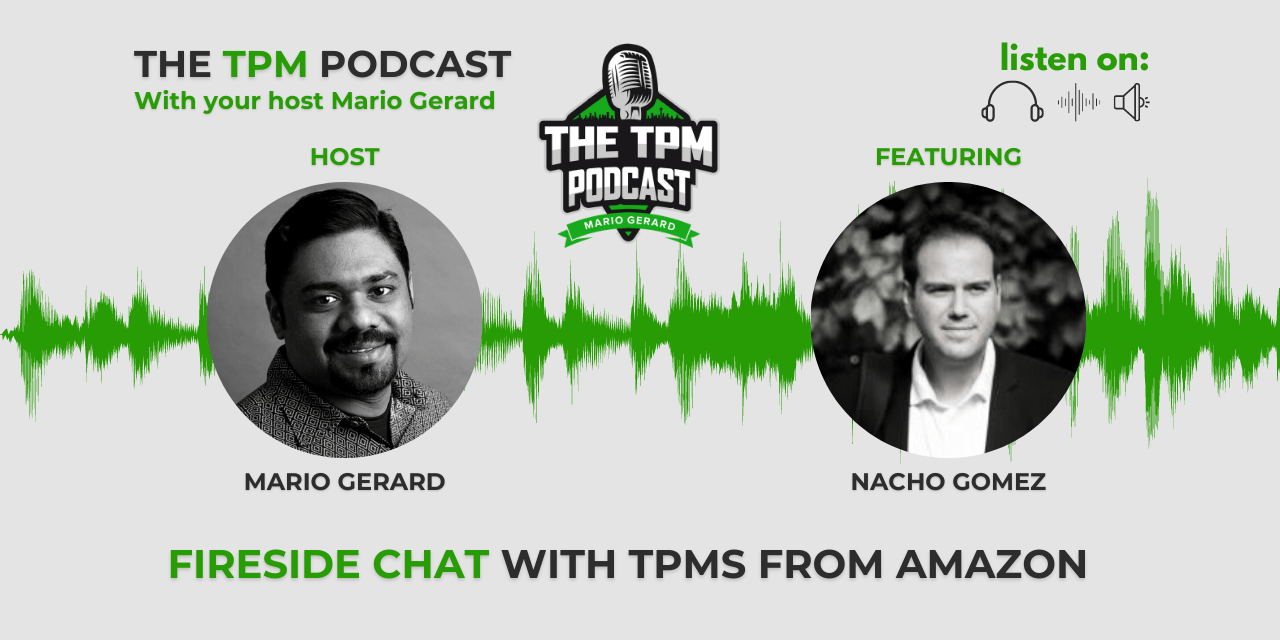
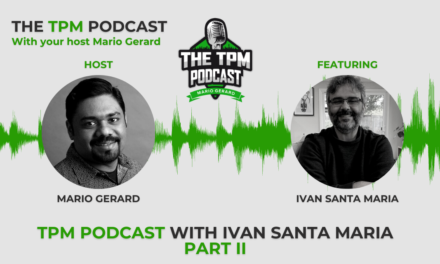
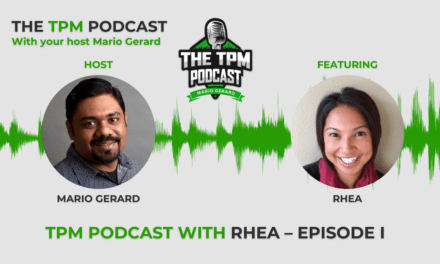
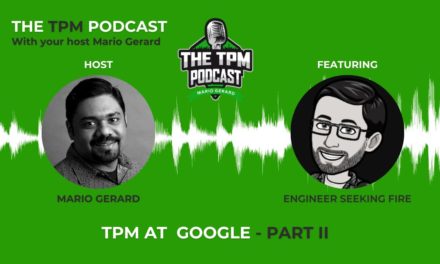
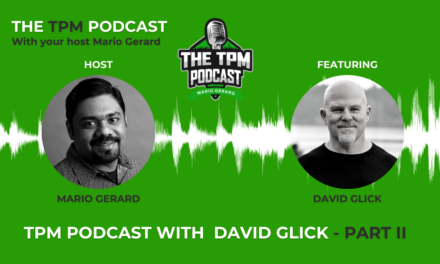





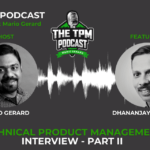


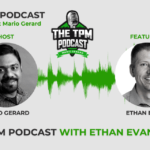



Thanks for this podcast. Enjoyed listening to it and very informative.
Hi Mario – thank you for continuing to post really interesting podcasts. You mentioned a post that has recently been written on a practical guide to what a TPM does. Would you mind adding that to the show notes here, please? Many thanks!